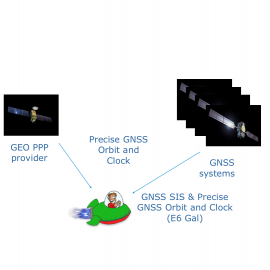
Low-cost multi-frequency multi-constellation GNSS antenna for CubeSats
DESCRIPTION
Satellites flying in LEO are relying more and more on Precise Orbit Determination (POD) through GNSS and in particular the computation of real time on-board POD with accuracy at centimetre level.
Receivers for in-orbit demonstration of Precise Point Positioning (PPP) currently under development under NAVISP (NAVISP-EL1-009: ‘Space GNSS Receiver for Un-Orbit Demonstration of PPP’) and the current activity will complement this development with an optimised antenna to be connected to such receivers. The availability of real-time on-board centimetre-level position accuracy in space will open the door to a myriad of applications (e.g. mega-constellations). Large platforms can afford costly and bulky antennas for very high performance. Smaller and cheaper platforms such as Cubesats need to embark low-cost, low-profile antenna solutions. Moreover, to exploit all the benefits of GNSS, a multi-frequency, multi-constellation solution is desirable. Current solutions available on the market are either too expensive or too bulky or limited in capability (e.g. single frequency). In addition to receiving navigation signals, modern receivers could potentially use the INMARSAT L-band as a communication channel for Precise Point Positioning (PPP). For this reason, it is considered beneficial to have a receive antenna covering the INMARSAT L-band too. In order to enhance performance in terms of multipath reduction, antennas mounted on high impedance surfaces (e.g. EBGs, meta-surfaces) could be a compact alternative to metallic chokes (choke rings). The space user antenna will be compliant with stringent phase centre stability requirements and have a low cost and low profile compatible with CubeSat missions.
Based on the above, the objective of the activity is to design and qualify a low-profile, low-cost antenna covering GNSS frequencies and INMARSAT L-band for CubeSat missions.
The tasks to be performed will include:
- Definition/consolidation of antenna requirements;
- State-of-the-art review of antenna concepts and technologies for GNSS space users;
- Design of the multi-frequency (L1/E1, L2/E6, L5/E5a and INMARSAT L-band), multi-constellation GNSS space user antenna, with a focus on high accuracy (very stable phase centre), low cost (<10 keuro) and low profile (< 1cm height);
- Manufacturing and testing of the GNSS space user antenna;
- Qualification of the GNSS space user antenna, in line with tailored ECSS for CubeSat.
The development of this antenna will bring advantages in the integration, footprint and performance of GNSS receivers for Precise Point Positioning for CubeSat missions.
The availability of real-time on-board centimetre-level position accuracy in space will open the door to a myriad of applications (e.g. mega-constellations).
esa-STAR link: http://emits.sso.esa.int/emits/owa/emits.main
